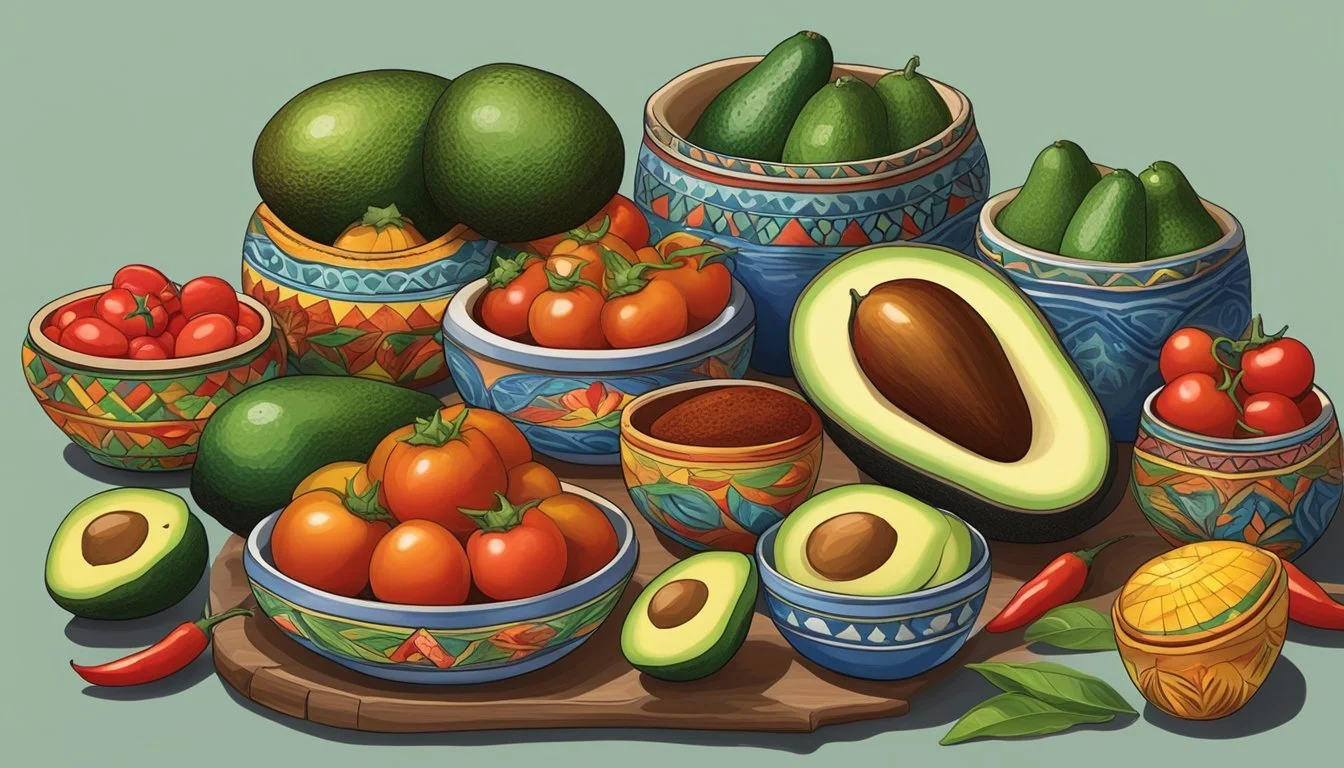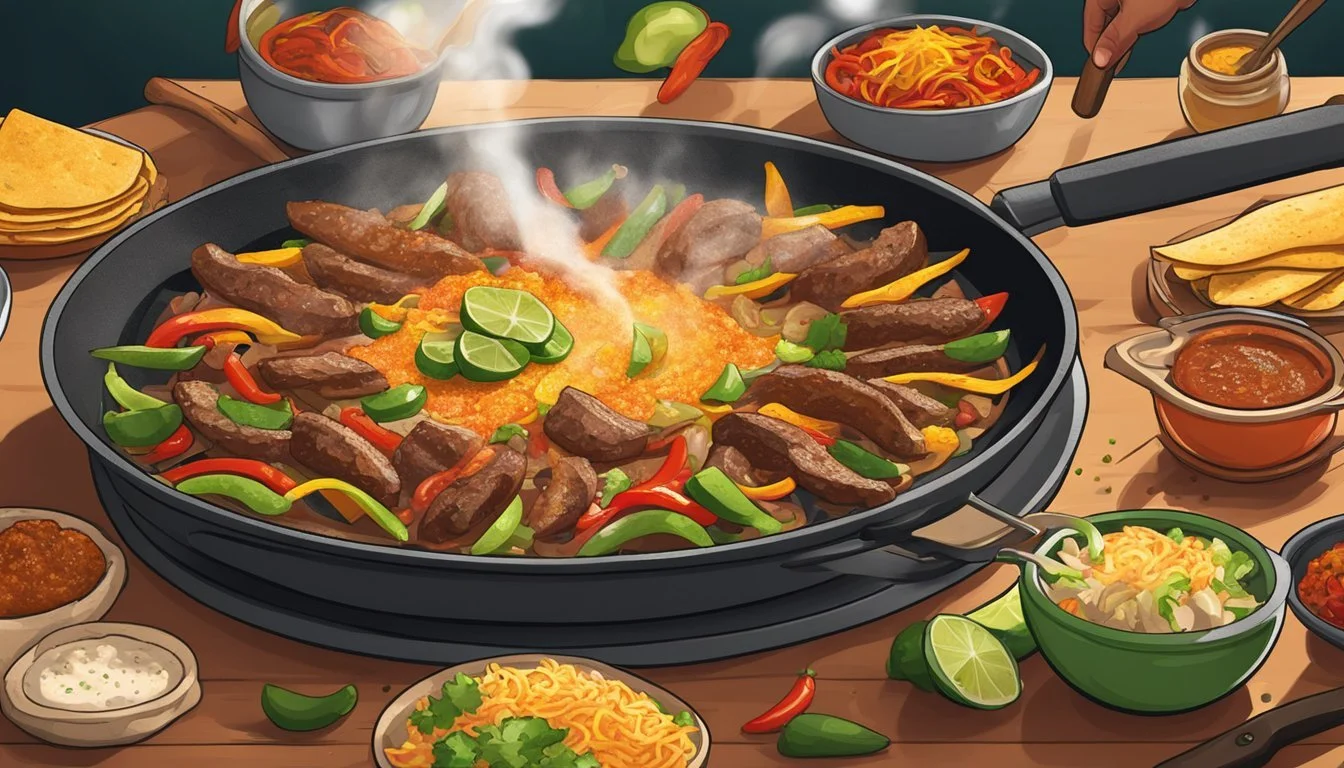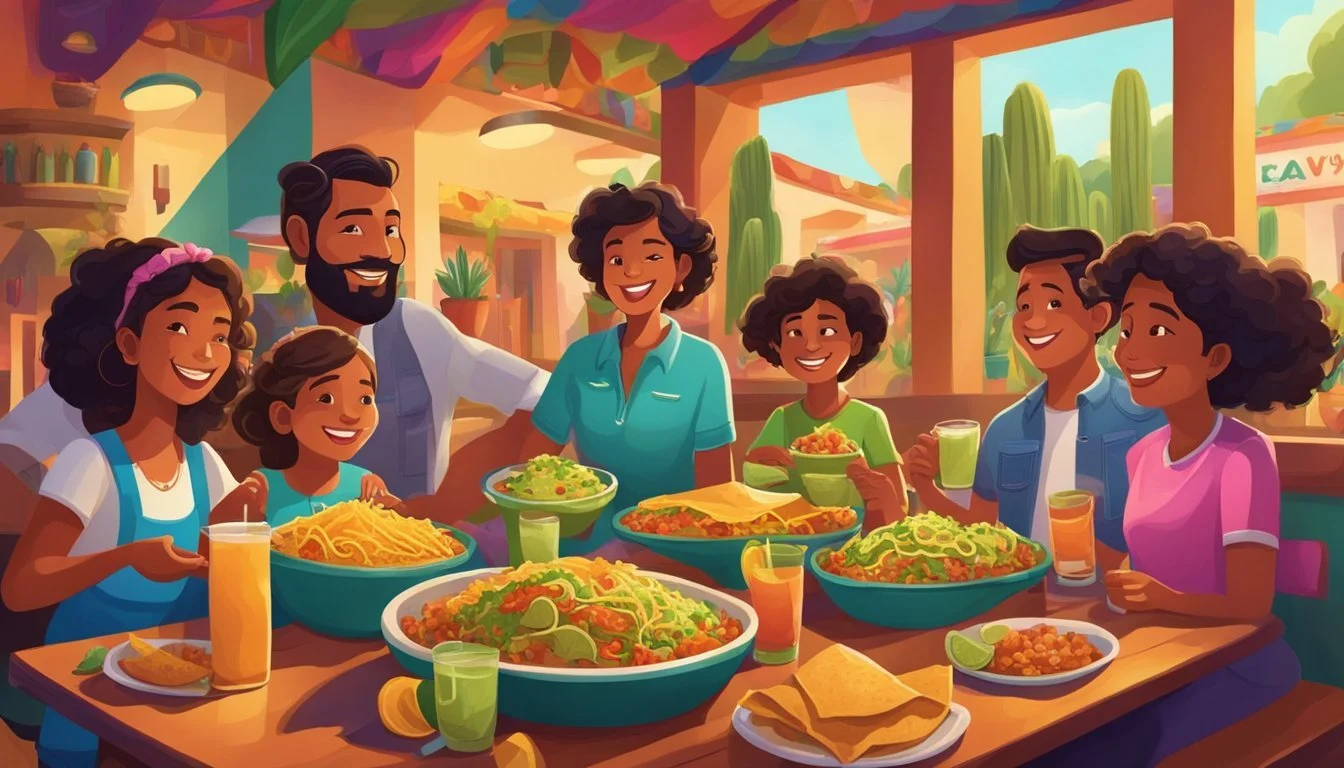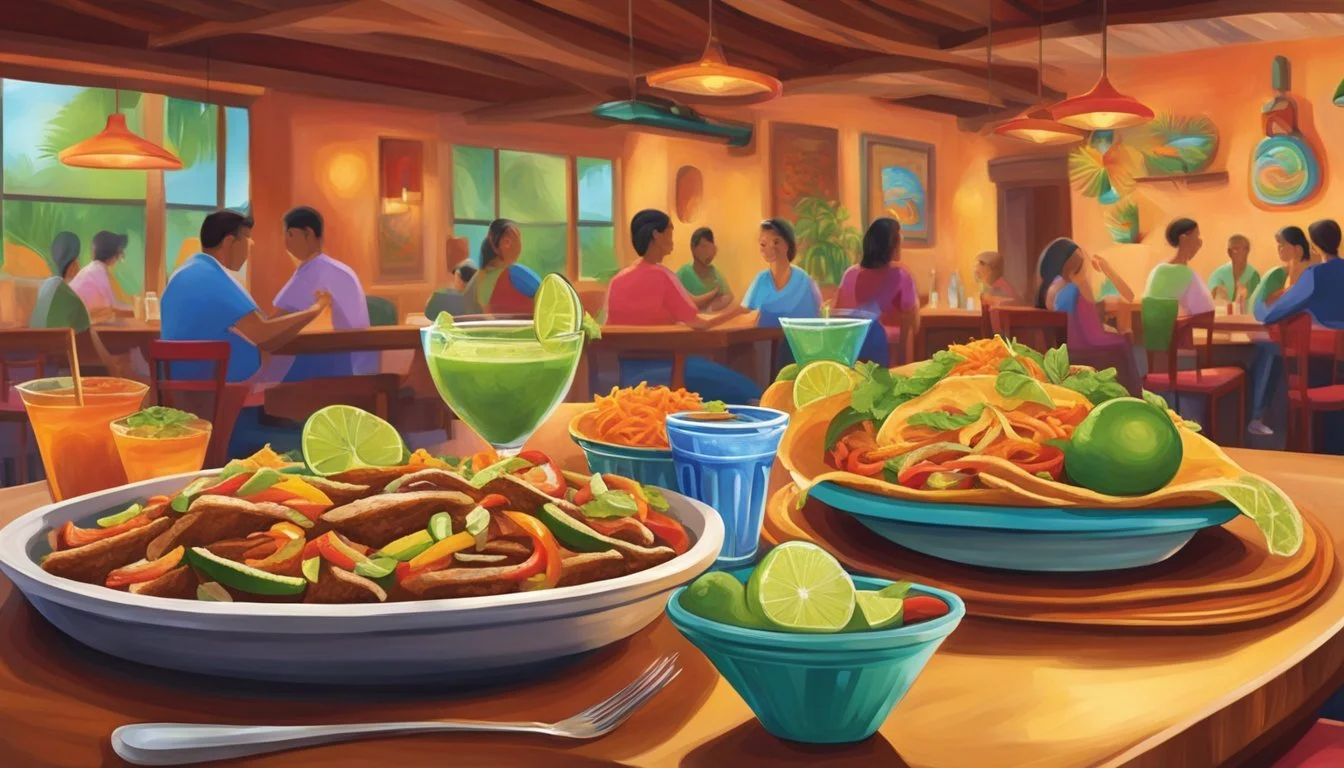Authentic Mexican Cuisine
A Guide to Traditional Flavors and Dishes
Discover > Truly Texan > Authentic Mexican Cuisine
Authentic Mexican cuisine is a vibrant and diverse tapestry of flavors, textures, and techniques that have evolved over centuries. It is deeply rooted in tradition and regional variations, reflecting the rich cultural heritage and geographical diversity of Mexico. From the basic staples made of corn (how long does corn last?), beans, and chilies to the wide array of herbs and spices, Mexican food (What wine goes well with Mexican food?) offers an extensive palette for the senses. Beyond the internationally renowned tacos and margaritas lies a world of culinary delights like elote, churros, posole, and enmoladas—each dish a testament to the history and community customs of its place of origin.
Traditional Mexican foods are not only about the ingredients but also the intricate culinary methods passed down through generations. Dishes such as chilaquiles, pozole, and various mole sauces showcase a blend of indigenous and European influences, primarily from Spanish cuisine. The authenticity of these dishes is marked by time-tested preparations and a dedication to preserving age-old skills.
As Mexican cuisine continues to gain global recognition, there is a growing interest in exploring the authentic recipes and dishes that make up this rich culinary landscape. Recipes are shared with careful attention to tradition, allowing even those far from Mexico to experience the depth of its flavors. The cooking of Mexico is a celebration of community and family, with each recipe carrying stories and memories, making it a vital part of the nation's cultural identity.
History and Origin
Mexican cookery is the result of a rich historical tapestry, weaving together the agricultural innovations of ancient civilizations with the influence of Spanish colonizers. This section explores the origins of authentic Mexican cuisine, highlighting the Aztec influence, the impact of the Spanish conquest, and its modern evolution.
Influence of the Aztecs
The Aztecs' culinary practices laid a fundamental foundation for Mexican cookery. They cultivated corn, beans, and chili peppers, staples that remain central to Mexican dishes today. Ceremonial dishes often included chocolate, a precious ingredient derived from cocoa beans, which the Aztecs traded and consumed as a beverage. Chocolate was not just food but played an integral role in Aztec culture.
The Spanish Conquest
With the arrival of the Spanish in the 16th century, Mexican cookery experienced significant change. The Spanish introduced new livestock, such as pigs and cows, and ingredients like sugar, dairy products, and vanilla. The melding of native Mexican ingredients with these new elements from Spain formed many traditional dishes that are now considered authentically Mexican.
Modern Evolution
Modern authentic Mexican recipes continue to evolve while maintaining its traditional roots. The global exchange of ideas and ingredients has introduced new culinary techniques and flavors, yet the core of traditional Mexican cookery—corn, beans, and chili peppers—remains unchanged. Contemporary chefs often interpret these ancient flavors with modern twists, showcasing the cuisine's adaptability and ongoing relevance.
Fundamental Ingredients
Authentic Mexican cuisine is characterized by its vibrant flavors and diverse ingredients ranging from fresh produce to a variety of meats, an array of spices and herbs, and essential pantry staples. Understanding these ingredients is crucial to creating the traditional tastes of Mexico.
Native Produce
Authentic Mexican recipes deeply integrate native produce like corn, tomatoes, avocados, and cacao (chocolate). Corn is not just a staple food but also the foundation of the rolled corn tortilla and warm corn tortillas (how long do corn tortillas last?), a key component in dishes such as tacos and enchiladas. Tomatoes are omnipresent, often found in fresh salsas (how long do fresh salsas last?) or cooked sauces. Avocado adds a creamy texture to salads and is the core ingredient in guacamole. Moreover, cacao and vanilla, both native to Mexico, are used for their rich flavors in a variety of sweets and some savory dishes.
Meats and Proteins
Mexican dishes frequently feature meats such as pork, chicken, and beef. Seafood is also prevalent, especially in coastal regions. Common preparations include grilling and shredding for fillings in tacos or tamales. Cheese plays a supporting role, with cotija cheese and crumbled queso fresco being salty, crumbly varieties often sprinkled over finished dishes.
Herbs and Spices
Key flavors in Mexican food come from herbs and spices like cumin, chili peppers, and fresh lime. Cumin is widely used for its warm and earthy note. Chili peppers come in many varieties, offering different levels of heat and complexity to dishes such as chiles rellenos and of course hot sauce (how long does hot sauce last?). The bright acidity of lime is essential for balancing the flavors.
If you're looking for cumin and chili pepper buying it online is your best bet!
Staple Pantry Items
Beyond fresh ingredients, Mexican food relies on several pantry staples. Beans serve as a significant source of protein and are commonly refried or served whole. Mexican rice often accompanies meals either as a side or part of a main dish. Nopales (cactus pads) are another staple, adding a unique flavor and texture to Mexican dishes. No Mexican pantry would be without a regular supply of tortilla chips (how long do tortilla chips last?).
Iconic Dishes
Authentic Mexican recipes boast an array of iconic dishes that are deeply rooted in tradition and regional diversity. From popular street food to elaborate sauces, each dish offers a unique taste of the rich cultural heritage with traditional Mexican cuisine.
Tacos and Tostadas
Tacos are a traditional Mexican dish, traditionally served in soft corn tortillas and can feature a variety of fillings such as beef, chicken, pork, or seafood. Tostadas represent a similar concept but are made with crispy, flat tortillas topped with beans, cheese, shredded lettuce, and other ingredients.
Tacos al Pastor: Made with marinated pork cooked on a spit and served with pineapple.
Tostadas: A crunchy tortilla base often topped with beans, shredded chicken or beef, fresh salsa and hot sauce.
Moles and Sauces
The complexity of Mole sauce, a blend of chilis, spices, and often chocolate, is a testament to authentic Mexican recipes. Multiple regions have their own variations, like the sweet and spicy black mole, usually paired with chicken.
Enmoladas: A corn tortilla filled with chicken, drenched in mole sauce, and sprinkled with sesame seeds (how long do sesame seeds last?).
Mole Poblano: A type of mole from Puebla, typically served over meat.
Soups and Stews
Pozole, a traditional stew made with hominy corn and meat, is often flavored with a variety of seasonings and garnished with lettuce, radish, red onion, lime, chili and tortilla chips. Meanwhile, Chiles en Nogada, a festive dish featuring poblano peppers stuffed with picadillo, represents Mexican pride with its colors mirroring the national flag.
Pozole: A hearty soup that comes in varieties like white (blanco), green (verde), and red (rojo).
Chiles en Nogada: Poblano chiles filled with a meat and fruit mixture, draped in walnut cream sauce and pomegranate seeds (how long do pomegranate seeds last?).
Street Food Specialties
Mexican street food is legendary, offering a plethora of flavors through dishes such as Sopes, Tamales, and Elote. Sopes are thick corn dough bases with a variety of toppings, while Tamales are corn dough parcels filled with meats or cheeses and steamed in a corn husk.
Elote: Grilled corn on the cob coated with mayonnaise, cheese, and chili powder.
Quesadillas: Folded tortillas filled with cheese and other ingredients, then cooked until the outside is crispy and the inside is melted.
Cooking Techniques
Authentic Mexican cookery boasts a tapestry of methods that brings out unique flavors and textures. Often rooted in tradition, these techniques are crucial for achieving the characteristic tastes found in this cooking.
The Art of Masa
Masa, a dough made from corn, is the foundation of numerous Mexican dishes like tortillas. Central to its creation is nixtamalization, a process where corn is soaked and cooked in an alkaline solution, usually limewater, then hulled. This not only enhances the nutritional value of the corn but also transforms its texture for use in various recipes.
Nixtamalization Process:
Soaking corn in an alkaline solution
Cooking until soft
Rinsing and hulling the corn
Grinding to form masa
Grilling and Roasting
Grilling and roasting are favored methods that impart a smoky flavor to meats and vegetables. Carne asada, literally "grilled meat," often refers to marinated beef, typically skirt or flank steak, grilled over an open flame. This cooking technique emphasizes the charred, caramelized exterior that is highly desired in traditional Mexican cuisine.
Slow Cooking
Slow cooking allows flavors to meld and meat to become tender and juicy. Carnitas, meaning "little meats," involves simmering pork in its own fat until succulent. The slow-cook method ensures the meat is flavorful, maintaining a delicate texture that is both crisp and tender.
Popular Slow-Cooked Dishes:
Carnitas
Barbacoa
Mole
No-Cook Preparations
No-cook preparations highlight the fresh, vibrant flavors of Mexican ingredients at their peak. Salsas and ceviches rely on the natural acids found in ingredients like lime juice and tomatoes to create bright, refreshing dishes that complement cooked entrees or stand alone as appetizers.
By understanding these techniques, one can better appreciate the complexity and care that goes into traditional Mexican cooking.
Regional Variations
Mexican cuisine exhibits a rich tapestry of regional variations, each area offering distinct flavors and traditions shaped by local ingredients and history.
The North of Mexico
In Northern Mexico, the arid climate influences the cooking, emphasizing beef, goat, and ostrich (What wine goes well with ostrich?). Dishes often have a focus on these meats, with beef birria tacos– a savory stew, being a noteworthy specialty. Tacos in this region are typically filled with grilled meats, reflecting the prominent ranching culture.
Southern Mexico
Southern Mexican cookery is known for its use of indigenous ingredients like poblano chiles. The region relishes in complex dishes such as mole, where these chiles are commonly incorporated. Traditional preparations honor ancestral methods, often using the earthy flavors of chile pepper local herbs and spices. Ancho and mulato chile pepper are used to flavor tamales.
The Yucatan Peninsula
The Yucatan Peninsula is recognized for cochinita pibil, a marinated pork dish cooked in an earth oven and favored for its tangy essence from lime juice. One can find this and other Mayan-influenced dishes here, with a distinct palate of achiote and citrus infusions setting them apart.
Coastal Regions
Seafood plays a starring role in the coastal regions, where fresh catches are enhanced with a variety of preparations. Salsa verde, made with tomatillos and green chilies, often accompanies fish and shrimp, highlighting the coastline's bounty with bright and zesty flavors.
Contemporary Trends
In recent years, Authentic Mexican cookery has seen vibrant trends that cater to diversified palates, with a focus on innovative fusion dishes, a revival of farm-to-table practices, and gourmet interpretations infused with regional flavors.
Fusion Cuisine
Fusion trends intensify as chefs blend Mexican culinary traditions with global flavors. Tex-Mex, for example, continues to evolve, incorporating newer, fusion elements into its array of dishes. These creative combinations often result in unique modern Mexican recipes that honor traditional ingredients while introducing international techniques and taste profiles.
Key Fusion Highlights:
Innovative tacos with global fillings
Asian-inspired Mexican sushi rolls with cooked shrimp
Farm-to-Table Movements
The farm-to-table movement enhances Authentic Mexican recipes by sourcing local, fresh ingredients. Chefs are collaborating with regional farmers and markets, bringing forth dishes that emphasize seasonal produce and sustainable practices. This grassroots approach has paved the way for more organic Mexican foods to emerge, reflecting the true flavors of the local terroir.
Note on Farm-to-Table:
Emphasis on seasonal vegetables
Support for local agriculture
Gourmet Interpretations
Gourmet interpretations of traditional dishes have led to an upscale transformation in Mexican dining. Chefs are redefining the dining experience by presenting Authentic Mexican food with a sophisticated twist, focusing on elevated presentations and high-quality ingredients. Such gourmet offerings often feature complex techniques and bold yet balanced flavors.
Gourmet Elements:
Refined plating of classic dishes
Use of high-end ingredients like truffles (What wine goes well with truffles?) and artisan cheeses
Home Cooking and Recipes
Authentic Mexican food is distinguished by its diverse flavors and traditional cooking methods. The following subsections delve into the heart of Mexican home cooking, offering a glimpse at staple dishes, festive foods, and treasured family recipes.
Staple Homemade Recipes
Mexican home cooking revolves around a variety of staple dishes that form the backbone of everyday meals. One such dish is carnitas, a slow-cooked pork recipe that is savory and tender, often seasoned with a blend of aromatic herbs and spices. Another cornerstone of Mexican food is beef birria, a hearty stew that combines the richness of beef with the depth of chipotle peppers in adobo sauce. To prepare these dishes at home, cooks primarily use fresh, locally sourced ingredients.
Carnitas Recipe
Time: Approximately 4 hours
Key Ingredients: Pork shoulder, orange juice, garlic, cumin. The orange juice adds flavor but acidity too to cut through the fat of the pork shoulder.
Beef Birria Recipe
Time: 6-8 hours
Key Ingredients: Beef shank, guajillo chiles, onion, bay leaves.
When it comes to getting the best deals, buying guajillo chiles and bay leaves online is the way to go!
Fiesta Fare
During celebrations and gatherings, Mexican recipes often become more elaborate, showcasing the vibrant and festive side of Mexican food. Dishes such as tamales and mole poblano are frequently featured, each requiring meticulous preparation and attentive cooking. Fiesta fare is meant to be shared, reflecting the communal spirit of Mexican culture.
Tamales Recipe
Time: Several hours to a full day
Key Ingredients: Corn husks, masa harina (how long does masa harina last?), chiles, pulled pork or chicken.
For the most extensive selection, I suggest buying masa harina online!
Mole Poblano Recipe
Time: Up to 4 hours
Key Ingredients: Ancho chiles, chocolate, cinnamon, roasted nuts (how long do nuts last?).
Save time and effort by ordering cinnamon online!
Family Heirlooms
In many Mexican homes, certain recipes are cherished and passed down through generations, often varying slightly from one family to another. These family Mexican food heirlooms are a bridge to the past and a testament to the enduring nature of Mexican culinary traditions. Each family may have its own take on sopes, chiles rellenos, or enchiladas, adding personal touches that make the dish uniquely theirs.
In these recipes, the essence of Mexican home cooking is evident, demonstrating the importance of tradition, flavor, and family in every homemade dish.
Eating Out
When exploring authentic Mexican food, dining out offers an immersive experience. One encounters a variety of flavors and atmospheres ranging from family-run restaurants to the bustling street markets.
Cultural Experience at Restaurants
Authentic Mexican restaurants provide diners with a rich cultural experience through a plethora of traditional Mexican food. These establishments often serve items like mole, a complex sauce with numerous ingredients including chili peppers and chocolate, or huitlacoche, a delicacy made from corn fungus. Chefs at these restaurants take pride in their heirloom recipes, giving patrons a taste of Mexico's culinary heritage.
Street Vendor Exploration
Street vendors are the heartbeat of Mexican food. They offer an array of fresh, flavorful snacks and meals that are integral to the daily life of locals. One might find vendors selling tacos, tamales, and elote, char-grilled corn smeared with mayonnaise, cheese, and chili powder. The street food experience is direct and unadorned, giving eaters a genuine taste of Mexican food.
Markets and Food Stalls
Local markets and food stalls are treasure troves for food enthusiasts seeking out authentic Mexican eats. Shoppers can discover a vibrant selection of fresh produce, meats, spices, and prepared foods. Markets like these are not only places to buy ingredients but often house food stalls where cooks prepare dishes on the spot, such as churros, posole - a hearty soup with shredded cabbage, sour cream, or regional specialties that reflect the local gastronomy.
Culinary Techniques
True to its rich cultural heritage, Mexican food employs a myriad of culinary techniques that enhance flavors and textures, making each dish a lively experience. From the meticulous preparation of ingredients to the traditional cookware and thoughtful presentation, each step is a testament to the culinary finesse that Mexican food is celebrated for.
Ingredient Preparation
In Mexican cookery, preparing ingredients involves specific techniques that are crucial to creating authentic flavors. Dried chilies, for example, undergo a rehydration process before being ground into a paste used for sauces like mole and adobo. Lime juice is often added to fresh green or red salsa and ceviches, not only for its acidic brightness but also to help in the culinary technique of denaturing proteins in raw fish.
Dried chilies: Rehydrate, then grind into paste.
Lime juice: Add to salsas and ceviches to enhance flavor and denature proteins.
Cookware and Equipment
Traditional cookware is at the heart of Mexican food. The molcajete, a mortar and pestle made from volcanic rock, is used to crush and blend spices as well as to make guacamole. Comales and cast iron pots are prevalent; the former, a flat griddle, is indispensable for tortillas and lightly charring vegetables. Many dishes are still cooked over an open flame, a method known as fuego directo, offering a unique smoky taste. The tortilla press is an essential item for shaping dough into even, perfectly flat tortillas ensuring uniform cooking.
Molcajete (mortar and pestle): Used for spices and guacamole.
Comal (griddle): Essential for cooking tortillas and charring vegetables.
Open fire (fuego directo): Imparts smokiness to various dishes.
Tortilla press: Shape dough into flat, evenly cooked tortillas.
Skip the lines and order your molcajete, comal, and tortilla press online for a stress-free shopping experience!
Plating and Presentation
Presentation in Mexican food showcases the vibrancy and rusticity of the dishes. Tomato sauce and other vividly colored salsas garnish plates not merely for aesthetic appeal but to indicate flavor and heat levels to the diner. The artful arrangement of food speaks to a deep respect for the eating experience, embracing both visual appeal and practicality in presentation.
Drinks and Beverages
The drinks landscape of Mexico is as vibrant and diverse as its foods, serving up flavors that range from sweet and creamy to rich and robust.
Traditional Mexican Drinks
In Mexican food, traditional beverages are deeply rooted in cultural heritage. One cannot talk about these classic drinks without mentioning a Margarita, a world-renowned cocktail made from tequila, lime juice, and orange liqueur, traditionally served with salt on the rim of the glass. Tequila and mezcal are two of the most iconic alcoholic beverages in Mexico, with mezcal offering a distinctly smoky flavor derived from the heart of the agave plant. Another classic is Horchata, a refreshing, sweet drink made from rice or almonds (how long do almonds last?), often flavored with cinnamon and sugar. It is beloved for its creamy texture and comforting taste.
Mexican Desserts
Mexican desserts are a rich tapestry that combines traditional ingredients like chocolate, cinnamon, and vanilla with various preparation styles that range from time-honored recipes to innovative modern interpretations.
Traditional Sweet Treats
They often start with churros, a quintessential sweet treat. These crispy, deep-fried dough sticks dusted with cinnamon sugar are typically served with a side of hot chocolate or dulce de leche for dipping. Conchas, another beloved option, are a type of sweet bread characterized by their shell-like pattern on the crust, hence the name, which means "shells" in Spanish. Conchas come in vanilla and chocolate flavors, catering to different palates.
Festive Desserts
Festive occasions often feature specific desserts that have become symbolic of celebration. For example, during weddings or large gatherings, it's common to find bite-sized Mexican Wedding Cookies, delicate treats that melt in the mouth, often enhanced with vanilla and dusted with powdered sugar.
Modern Twists
Innovative chefs have introduced modern twists on classic desserts, such as infusing traditional flavors like chocolate and vanilla into familiar forms with unexpected textures or complementary elements. One might encounter a deconstructed tres leches cake or a chocolate mousse with a hint of chili, which speaks to the evolving nature of Mexican cuisine and its openness to experimentation while maintaining its authentic roots.
Dietary Adaptations
Authentic Mexican cuisine offers a variety of options catering to different dietary needs, from plant-based diets to gluten sensitivities and health-centric preferences.
Vegetarian and Vegan Options
Mexican cuisine provides ample vegetarian and vegan options through its traditional use of beans and corn as staple ingredients. For a balanced vegetarian dish, one could turn to the robust flavors of pinto beans (how long does pinto beans last?), staple offerings that are often served as refried beans or as part of a wholesome bean soup with sour cream. Vegans can savor tomatillos and avocados in guacamole or salsa verde, both of which add a creamy texture and rich flavor to plant-based dishes without the need for dairy.
Gluten-Free Alternatives
Those requiring gluten-free diets can find safety in the traditional Mexican reliance on corn as a key ingredient, as it naturally contains no gluten. Dishes like a soft corn tortilla and tamales made from nixtamalized corn flour (how long does corn flour last?) provide satisfying alternatives to wheat-based counterparts. Moreover, the use of rice and beans as sides or main components ensures that individuals with gluten sensitivities can enjoy a variety of Mexican dishes without compromise.
Health-Conscious Choices
Health-conscious diners often seek out Mexican food for its fresh ingredients and the availability of flavorful, lower-calorie options. Legumes, including varieties of beans, are a source of protein and fiber, which are essential for those looking to maintain a nutritious diet. Grilled fish tacos, ceviche with lean seafood, and salads with avocado offer heart-healthy fats and are light yet satisfying choices. Additionally, dishes can be easily adapted to reduce dairy intake by forgoing cheese and sour cream, favoring dairy-free alternatives such as avocado for richness.
Final Thoughts
When appreciating authentic Mexican cuisine, one should recognize its profound cultural depth, with recipes passed down through generations. It is not merely a type of food; it's a tapestry woven with history and tradition. Authentic Mexican food often features fresh local ingredients like chilies, tomatoes, corn, beans, and an assortment of herbs and spices.
The flavors of Mexican cuisine are diverse, where one can experience a range of smoky and spicy tones. It's important to distinguish these genuine offerings from Tex-Mex, which tends to lean heavily on cheese, ground beef, and flour tortillas. Authentic dishes like tacos al pastor reveal a blend of cultural influences, illustrating the dynamic evolution of Mexican gastronomy.
One cannot talk about Mexican cuisine without celebrating its iconic dishes:
Tacos: A staple, found in endless regional variations.
Enchiladas: Rolled tortillas drenched in chili sauce.
Chiles en Nogada: Poblano chilies filled with picadillo, topped with a walnut-based cream sauce and pomegranate seeds, reflecting the colors of the Mexican flag.
Mexican cuisine offers a rich sensory experience, from the enticing aromas to the complex layers of flavor and texture. Cultural appreciation goes beyond enjoying the meal; it involves recognizing the significance each dish holds in Mexican society. They should engage with Mexican cuisine thoughtfully and with respect, acknowledging its place as a vital form of cultural expression.






